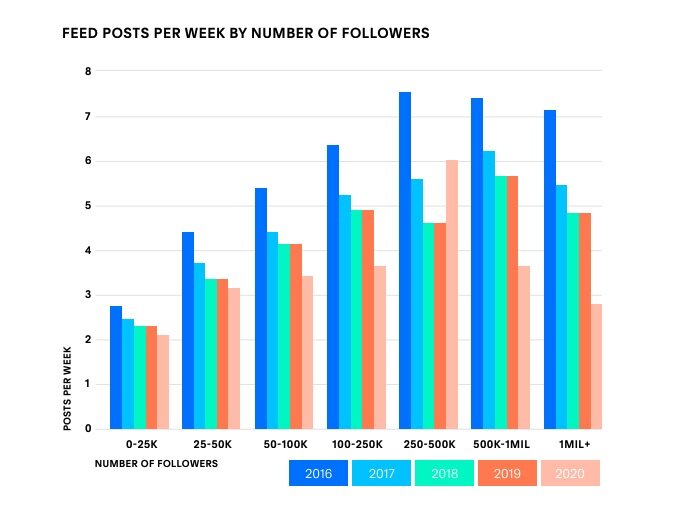2020 Predictions: The Influencer Edition
Over the last decade, the Influencer Market has become a beast, and it's not going anywhere anytime soon.
Influencers remain a driving force for brand awareness and conversion, with changes like Branded Content posts and hidden like counts adding new layers to influencer relationships.
Here’s what we see coming for the Influencer Market in 2020!
Quality over Quantity: Less Frequent Feed Posts
With the introduction of Story feed and changes in the algorithm, influencers and brands alike have gradually decreased their Feed-posting frequencies.
At the same time, both have begun to increase Story content. While both the Feed and Story have begun to skew more “authentic” (less filtered and curated), influencers commonly take to their stories for off-cuff posts that allow their followers a window into their daily life. They often reserve their most curated branded content for feed posts, and diversify their relationships to employ both content types.
Later recently reported that over the past four years, influencer Feed post frequency has seen a gradual decrease across the board. We predict that 2020 will follow this trend, with the exception of Macro-influencers in the 250-500k range increasing their post frequency.
Decreasing the quantity of branded posts in their feed will allow influencers to increase the quality of each post, which will also be evident as influencer captions evolve to a mini-blog format.
Increasing Hashtag Strategy
While influencer Feed post frequency is predicted to decline, the opposite can be said for both influencer hashtag use and caption length.
With low organic discoverability, many influencers have started to use a hashtag strategy in an to increase organic reach and engagement. Later reports that this theory could have strong positive implications for influencer engagement rates, especially for influencers with less than 25k followers.
It should be noted that other changes to the platform including a new algorithm and introduction of the Explore page could also be contributing factors to engagement rate trends.
For brands, this means both employing a hashtag strategy of your own to increase organic visibility, and integrating branded hashtags into your existing strategy.
Establishing a strong, catchy, and versatile branded hashtag that can be used across campaigns is the first step. Social Supply Co client Eagle Creek exemplifies this with their tag #FindYourUnknown.
This tag hits on 3 top goals you should consider when creating your branded hashtag:
Is it directly connected to the brand and/or product?
Is it simple to use?
Is it applicable across a variety of campaigns connected to the brand?
Eagle Creek is an adventure travel luggage brand, so a tag that encourages use of their products in an adventurous context is right on the mark. Another brand employing this strategy is REI, whose #OptOutside tag is simple, widely applicable, and directly connected to the brand’s mission.
Notice that neither uses their brand name in their branded tag. Using just your brand’s name can have a confining effect, narrowing use and visibility. Don’t be afraid to branch out!
We predict that 2020 will see a continuation of increased hashtag strategy by both brands and influencers looking to increase their organic visibility, and with influencers and UGC helping brands expand use of their branded tags.
Mini-Blog Captions: Increasing Influencer Caption Length
Ideal caption length is often a debate, with most brands strongly on the shorter side and influencers making up most long-form captions.
It looks like long-form captions are here to stay among influencer accounts, with increasing caption length associated with higher engagement rate.
Influencers form strong relationships with their audience through sharing information and opinions, so it’s no surprise that many influencer captions read like mini-blogs, or even vlogs with the rising popularity of IGTV.
Now more than ever, the Instagram audience expects to be advertised to. More information from influencers on the why behind product endorsements leads to greater trust. This can correlate to more influencer conversions for your brand!
Later reports a positive correlation between Influencer caption length and engagement rate, predicting the highest engagement on influencer posts with 1000+ characters.
As a brand, this information should inform the way that you manage your influencer relationships:
Look to influencers in the micro to macro range as this indicates a stronger audience relationship (hello engagement!) and encourage influencers to write.
When possible, supply writing prompts. Ask questions that will encourage answers that speak to certain product features.
Give a little inspo, but always have your influencers write from their own voice and experience using your product.
You’ll recall our first prediction for 2020, Quality over Quantity. Influencers will be likely to employ this when entering into brand relationships, favoring products that they personally connect to and engaging in a smaller number of paid partnerships as opposed to a multitude of product trades with low commitment.
Emphasis on Authenticity and Transparency
The Instagram audience knows when they are being advertised to. They understand that influencers they follow are being compensated for brand endorsements, and they expect influencers to honor their connection to their audience with clear and concise disclosure.
Successful influencers like @officiallyquigley strike a balance between transparent disclosure and their own authentic voice, seamlessly weaving branded content into their Feed. With increasingly authentic and transparent copywriting from influencers, Branded Content feels like an easy fit alongside the influencer’s personal content.
With Facebook expanding their Brand Collaborations Manager to include Instagram influencers and branded collaborations, it seems they are swiftly moving to enter the influencer platform space.
We predict that in 2020, Branded Content collaborations will increase as Instagram moves to build out their platform while simultaneously limiting the capabilities of third party influencer platforms with changes like private like counts. This will also open the door for brands to expand their reach through direct access to influencer audiences for ad management purposes, as well as the opportunity to turn Branded Content posts into ads that deliver to the influencer’s audience from the influencer’s page.










